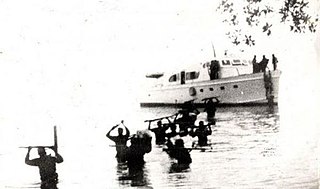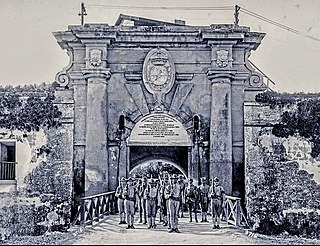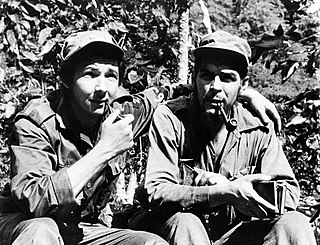Related Research Articles

Granma is a yacht that was used to transport 82 fighters of the Cuban Revolution from Mexico to Cuba in November 1956 to overthrow the regime of Fulgencio Batista. The 60-foot diesel-powered vessel was built in 1943 by Wheeler Shipbuilding of Brooklyn, New York, as a light armored target practice boat, US Navy C-1994, and modified postwar to accommodate 12 people. "Granma", in English, is an affectionate term for a grandmother; the yacht is said to have been named for the previous owner's grandmother.

The 26th of July Movement was a Cuban vanguard revolutionary organization and later a political party led by Fidel Castro. The movement's name commemorates the failed 1953 attack on the Moncada Barracks in Santiago de Cuba, part of an attempt to overthrow the dictator Fulgencio Batista.

Alberto Díaz Gutiérrez, better known as Alberto Korda or simply Korda, was a Cuban photographer, remembered for his famous image Guerrillero Heroico of Argentine Marxist revolutionary Che Guevara.
Pico Turquino, sometimes erroneously spelled as Pico Torquino, is the highest point in Cuba. It is located in the southeast part of the island, in the Sierra Maestra mountain range in the municipality of Guamá, Santiago de Cuba Province. It is the only place in Cuba where snowfall has been officially recorded, which last fell in February 1900.

The Sierra Maestra is a mountain range that runs westward across the south of the old Oriente Province in southeast Cuba, rising abruptly from the coast. The range falls mainly within the Santiago de Cuba and in Granma Provinces. Some view it as a series of connecting ranges, which join with others to the west. At 1,974 m (6,476 ft), Pico Turquino is the range's – and the country's – highest point. The area is rich in minerals, especially copper, manganese, chromium, and iron.
Herbert Lionel Matthews was a reporter and editorialist for The New York Times who, at the age of 57, won widespread attention after revealing that the 30-year-old Fidel Castro was still alive and living in the Sierra Maestra mountains. President Fulgencio Batista claimed publicly that the young guerrilla leader had been killed during the landing of the yacht Granma, bringing him and others back to Cuba from Mexico in December 1956.
During the Cuban revolution, escopeteros were essential scouts and pickets from the Sierra Maestra and other mountain ranges to the plains. The "escopeteros" were responsible for semi-continuously holding terrain against smaller sized Batista patrols. The escopeteros provided first alerts, communications, protected supply routes, provided essential intelligence and often captured weapons which were sent up to the mainline Castro forces in the high mountains.

Fortaleza de San Carlos de la Cabaña, colloquially known as La Cabaña, is an 18th-century fortress complex, the third-largest in the Americas, located on the elevated eastern side of the harbor entrance in Havana, Cuba. The fort rises above the 60-meter (200 ft) hilltop, along with Morro Castle. The fort is part of the Old Havana World Heritage Site which was created in 1982.
Radio Rebelde is a Cuban Spanish-language radio station. It broadcasts 24 hours a day with a varied program of national and international music hits of the moment, news reports and live sport events. The station was set up in 1958 by Che Guevara in the Sierra Maestra region of eastern Cuba, and was designed to broadcast the aims of the 26th of July Movement led by Fidel Castro.
Fernando Ramón Martínez Heredia was a prominent Cuban revolutionary thinker and politician. Martínez was a founding member of the Cuban Communist Party, and as a member of the July 26 Movement, he took part in the Revolution which overthrow the Batista dictatorship.

A guerilla foco is a small cadre of revolutionaries operating in a nation's countryside. This guerilla organization was popularized by Che Guevara in his book Guerilla Warfare, which was based on his experiences in the Cuban Revolution. Guevara would go on to argue that a foco was politically necessary for the success of a socialist revolution. Originally Guevara theorized that a foco was only useful in overthrowing personalistic military dictatorships and not liberal democratic capitalism where a peaceful overthrow was believed possible. Years later Guevara would revise his thesis and argue all nations in Latin America, including liberal democracies, could be overthrown by a guerilla foco. Eventually the foco thesis would be that political conditions would not even need to be ripe for revolutions to be successful, since the sheer existence of a guerilla foco would create ripe conditions by itself. Guevara's theory of foco, known as foquismo, was self-described as the application of Marxism-Leninism to Latin American conditions, and would later be further popularized by author Régis Debray. The proposed necessity of a guerilla foco proved influential in Latin America, but was also heavily criticized by other socialists.

Harry "Pombo" Villegas was a Cuban communist guerrilla. He was born in Yara and was a descendant of African slaves. He fought alongside Che Guevara in battles from the Sierra Maestra to the Bolivian insurgency. From 1977 to 1979, and again from 1981 to 1988, Villegas was part of the leadership of Cuba's volunteer military mission in Angola, fighting alongside Angolan and Namibian forces against aggression by South Africa's apartheid regime. Villegas was a Central Committee member of the Communist Party of Cuba from 1997 to 2011, a deputy of Cuba's National Assembly, and executive vice president of the Association of Combatants of the Cuban Revolution.

Ernesto "Che" Guevara was an Argentine Marxist revolutionary, physician, author, guerrilla leader, diplomat, and military theorist. A major figure of the Cuban Revolution, his stylized visage has become a ubiquitous countercultural symbol of rebellion and global insignia in popular culture.

Che Rise and Fall is a documentary film created by Eduardo Montes-Bradley. The film was entirely shot in Cuba at the time Che Guevara’s remains was airlifted from Bolivia to Santa Clara the final resting place. The documentary features the testimonies of Guevara’s comrades-in-arms in Sierra Maestra, Congo and Bolivia, also with Alberto Granado with whom Guevara rode a motorcycle from Argentina on a trip that will end 16 years later in the jungles of Bolivia, an experience that was brought to the big screen on The Motorcycle Diaries. Che Rise and Fall begins with an account of Guevara's death in Bolivia in 1967 and fittingly ends with footage of the return of his remains for interment in a monument in Santa Clara's Revolution Square some 30 years later.
Santiago Rafael Armada Suárez or Santiago Armada was a Cuban artist and designer. He was also known by the nickname Chago.

The Santa Ifigênia Cemetery, officially Santa Ifigênia Patrimonial Cemetery, is the cemetery, necropolis and main pantheon of the Cuban Oriente and the city of Santiago de Cuba. It is located west of the city, more specifically in the José Martí district and stands out for being the resting place of the remains of a large number of heroes and famous figures in the history and culture of Cuba, including José Martí and Fidel Castro.
Abel Sierra Madero is a Cuban author and scholar who was awarded the Casa de las Américas Prize in 2006.
The attack on El Uvero was an armed confrontation between the 26th of July Movement and the Cuban military on May 28, 1957, part of the Cuban Revolution. It was the first major confrontation between the 26th of July Movement, led by Fidel Castro, and the Cuban military, led by Fulgencio Batista, since the latter settled in Sierra Maestra.
Eduardo "Lalo" Sardiñas was a combatant of Cuban Revolution, and a member of the 26th of July Movement, led by Fidel Castro during 1958 and 1959.
Armando Acosta Cordero,, known as Captain Erasmo Rodríguez, was a commander of the Cuban Rebel Army. From a very young age he participated in the struggle, with the Popular Socialist Party. He joined the Rebel Army in the Sierra Maestra and later joined Column 8 Ciro Redondo with which he contributed to liberate, different towns as well as his hometown.
References
- 1 2 3 Articles by Che Guevara from the Sierra Maestra by Ernesto 'Che' Guevara, The Militant , Vol. 10 / no. 3, January 22, 1996